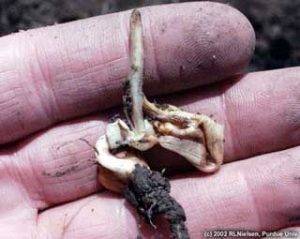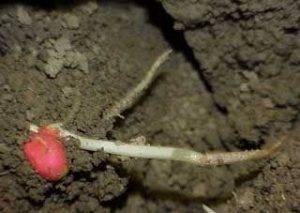Early Season Frost or Freeze Damage in Corn
The virtue of patience is most beneficial when the time comes to assess frost or freeze damage in early-season corn. Once a frost or freeze event takes place, do an initial assessment of your field and wait 3-5 days before making any final decision on how to proceed. Young corn plants can tolerate cool temperatures up to V5 since the growing point is still below the soil surface. Early season damage caused by the cold temps does not show up immediately as the cells that get broken from the freezing moisture inside the plant may look normal the first morning after a freeze. Depending on the actual low temperatures, symptoms may take a day or so to appear.
Frost Damage Assessment
- Identify Location – Note field locations that experienced the cold temperatures. Also note the lay of the land in those fields such as low spots, hill tops, general slope direction.
- Soil Moisture – Record the soil moisture levels across the entire fields, possible dry hill tops and wetter low areas. Moist soil can offer some protection.
- Soil Temperature – Check soil temp in different location across the field.
- Soil Type – Be conscious of the soil type. Sandy soil cools much faster than silty or clay soils.
- Weather Data – Utilize location weather station info to determine the lowest temperature and duration of that temperature.
Frost Damage

Corn at V4 damaged from frost event. Above-ground tissue is dead (brown) but the growing point was still below-ground and is alive (white-yellow tissue)
Young corn plants can tolerate some low temperatures and still survive and achieve high yields. The growing point of the plant remains under the soil until the plant reaches V5. At this stage, you will see five leaf collars showing around the stem. You may have more leaves visible, so count the collars for accurate assessment of crop stage. Low temperatures that do not fall below 30 degrees generally just damage the exposed leaves and do not hurt the growing point. However, recovery of these plants may take some time (up to a full week) depending on weather after the frost. Below is a photo from the Iowa State University Integrated Crop Management newsletter showing a viable growing point after a frost event.
Frost Damage Management
- Wait 3 to 5 days with temps above 70 degrees. Wait even longer with lower temperatures.
- Assess percentage of damaged plants and survival rate prior to any replant decision.
- Allow plants to recover prior to any herbicide or fertilizer applications, this may take a week to 10 days.
- Note the amount of leave tissue lost and how it will affect your crop staging.
- Loss of two leaves in 4 leaf corn will still be classified as V4. This becomes important for later application of herbicides. Keep the leaf loss in mind when staging corn for later applications to assure you are not past a window that may cause herbicide injury.
Freeze Damage
If you experience low temperatures of 28 degrees or lower for a prolonged period of time, most all the plants in a field will show significant damage. These extended low temperature situations become more critical for assessment. You may see variation across a field due to soil type, soil moisture content or the amount of residue on the field. Corn damaged by a hard freeze will still need patience for assessment. Assess all fields after hard freezing temperatures, even those that have not emerged yet. Check soil temps at 2” level soon after a freeze for a sound understanding of the scope of damage to a field.
Freeze Damage Assessment
- Soil Temps – Check soil temps at 2” level in multiple locations of the damaged field to gain knowledge of how widespread the damage has occurred. This needs to be recorded early.
- Patience – Wait 3-5 days to allow the full expression of effects of the freeze.
- Plant Tissue – Slice open young plants and observe the growing point. Brown and water-soaked tissue vs white or green tissue. See earlier photo for viable plant.
- Dig Un-emerged Seeds – Hard kernels remain viable while soft/mushy kernels will not germ or have the energy to push the sprout through the soil.
The photo on the left shows leafing out underground due lack of energy of seedling. The photo on the right shows damage to the coleoptile that will result in shoot not having capacity to push through the soil. Photo courtesy of RL Nielsen, Purdue Univ.
Freeze Damage Management
- Wait 3 to 5 days with temps above 70 degrees, longer if lower temps.
- Slice open emerged plants and determine percentage of population damaged.
- Dig up un-emerged seedlings and kernel assess viability and determine percentage of population damaged.
- If stand damage is substantial, assess the costs and benefits of leaving the stand versus replanting.
Patience is key when assessing damage from a frost or freeze event. If you allow time for the crop to respond to the event, you will make better decisions for that damaged field.

